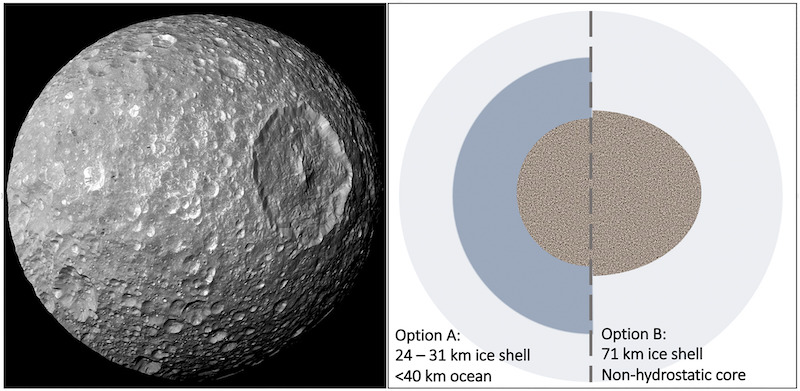
Ocean worlds are common in our solar system. There’s Earth, of course. But scientists also know or suspect that some dwarf planets, and moons of major planets, have subsurface oceans hidden beneath crusts of ice. On January 31, 2023, scientists announced we can potentially add Saturn’s tiny moon Mimas to that list.
Researchers at the Southwest Research Institute (SwRI) and Purdue University said their new study suggests Mimas might represent a new class of objects: small, “stealth” ocean worlds. That is, they’re worlds whose surfaces don’t betray their inner oceans. Researchers first published their peer-reviewed findings in Geophysical Research Letters on December 26, 2022.
And SwRI reported on the study on January 31, 2023.
A hidden ocean on Saturn’s moon Mimas?
Mimas is the smallest and least massive of the inner round moons of Saturn. (Other even smaller moons are irregular in shape due to not having enough gravity to form into spherical bodies). In fact, Mimas is only 246 miles (396 km) in diameter. Could a body that small even generate enough internal heat to maintain an ocean? The surprising answer is yes, if the researchers are correct.
Alyssa Rhoden at SwRI is the second author of the paper. She and her colleagues said that their study provides evidence for a thinning ice shell and a geologically young ocean beneath it. She said:
In the waning days of NASA’s Cassini mission to Saturn, the spacecraft identified a curious libration, or oscillation, in Mimas’ rotation, which often points to a geologically active body able to support an internal ocean.
Mimas seemed like an unlikely candidate, with its icy, heavily cratered surface marked by one giant impact crater that makes the small moon look much like the Death Star from Star Wars. If Mimas has an ocean, it represents a new class of small, ‘stealth’ ocean worlds with surfaces that do not betray the ocean’s existence.
How could Mimas have an ocean?
Most of the other moons and dwarf planets that have (or at least likely have) oceans are much larger than Mimas. Jupiter’s moon Europa, for example, is 1,900 miles (3,100 km) in diameter. Pluto is 1,476 miles (2,376 km). Saturn’s largest moon Titan is 3,199 miles (5,149 km) across.
They can be smaller, though, too. Saturn’s moon Enceladus, the one with the famous jets of ocean spray, is only about 310 miles (500 km) in size. It’s still larger than Mimas, though.
So, how would little Mimas be able to maintain an ocean inside it? The moon’s largest crater, Herschel Crater, is key to solving the puzzle. It’s what makes Mimas look like the Death Star from Star Wars.

Herschel Crater provides clues
The researchers modeled the formation of the crater using iSALE 2D simulation software. The results showed that Mimas’ ice crust had to be at least 34 miles (55 km) thick at the time of the impact that formed the crater. However, models say that the moon’s ice crust must currently be no more than 15-19 miles (24-31 km) thick if there is an ocean.
If that is the case, then the ocean must have been warming and expanding ever since the impact occurred. The observational results from Cassini are the most consistent with the ocean hypothesis. The paper states:
Mimas’ small size, lack of geologic activity and high eccentricity suggest a frozen, inactive history. However, Cassini libration measurements are best explained by a present-day liquid ocean under an ice shell 24–31 km thick, a configuration that tidal heating can support. These unexpected findings have motivated further study of Mimas’ surface geology to constrain its interior evolution.
The paper continues:
Mimas, a small moon of Saturn, is heavily cratered and lacks the typical characteristics of an ocean-bearing moon, such as the active surface of its neighboring moon, Enceladus. However, measurements of Mimas, made by the Cassini mission, are best explained by an ocean under a relatively thick ice shell.
Here, we try to understand how this ice shell and ocean may have changed with time by modeling the formation of Mimas’ largest impact basin, Herschel. When such large impacts occur, the shapes and depths of the resulting basin can be affected by the presence of the ocean. We find that Herschel could not have formed in an ice shell at the present-day thickness without obliterating the ice shell at the impact site.
Was Saturn’s moon Mimas always frozen?
Another model suggests that the water inside Mimas has always been frozen. But as co-lead author Adeene Denton at the University of Arizona explained, it is the warmer ocean model that best explains the current shape of Herschel Crater:
If Mimas has an ocean today, the ice shell has been thinning since the formation of Herschel, which could also explain the lack of fractures on Mimas. If Mimas is an emerging ocean world, that places important constraints on the formation, evolution and habitability of all of the mid-sized moons of Saturn.
Rhoden added:
Although our results support a present-day ocean within Mimas, it is challenging to reconcile the moon’s orbital and geologic characteristics with our current understanding of its thermal-orbital evolution. Evaluating Mimas’ status as an ocean moon would benchmark models of its formation and evolution. This would help us better understand Saturn’s rings and mid-sized moons as well as the prevalence of potentially habitable ocean moons, particularly at Uranus. Mimas is a compelling target for continued investigation.
Bottom line: A new study suggests that Saturn’s moon Mimas may have a subsurface ocean. If so, the “Death Star” moon would join other ocean moons in the outer solar system.
Source: Tracking the Evolution of an Ocean Within Mimas Using the Herschel Impact Basin











